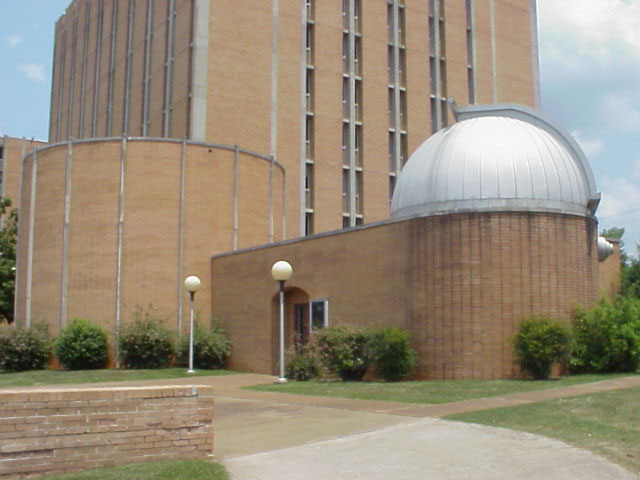History of the Planetarium

"Those who do not remember history are doomed to repeat it!"
Construction
Construction of the UNA Planetarium and Observatory was done in two stages, with the observatory being constructed first. In 1964 what would eventually become University of North Alabama was then known as Florence State College. It was proposed that the College acquire an observatory and planetarium. At the time, the space race was well under way and investments were being made across the country in math and science.
The first stage of the project was construction of the observatory. The building was constructed and the dome hoisted into place on March 15, 1964. The event was the culmination of a four year effort on the part of the local Florence Astronomy Club. The group wanted a telescope that would provide public views of the sky that was accessible and did not require driving long distances. Conversations with the college led to the project. Florence State College was interested in a planetarium and observatory and it was a natural alliance.
The show piece of the observatory was the 14.5 inch telescope that was to be the second largest telescope in the state. The mirror was ground by hand by members of the Astronomy club, who also constructed the telescope. On August 3rd, 1967 the telescope was placed into the dome after three years of labor by the amateur astronomers. The telescope weighed approximately a ton and was valued at $15000 in 1967.
The planetarium building was constructed alongside the telescope dome, providing access to both facilities. The planetarium projector was a Sptiz model A3P, and was state of the art for that time.
Development
Under its first director, Mr. Henry Harvey, the public would begin access to the facility that fall. Mr. Harvey would be director from 1967 to 1979.
After the term of Mr. Harvey ended, Dr. Dave Currot became planetarium-observatory director. He ran the planetarium from 1980 to 1999. The planetarium and observatory was then passed to the hands of the department chair, Dr. Tony Blose. Under his direction a new electronic control system manufactured by Northeast Control Systems was obtained to replace the original Spitz controls. Dr. Blose served as planetarium-observatory director from 1999 to 2007. On January 7th, 2008 Dr. Mel Blake was named planetarium-observatory director with a mandate to modernize and develop the programs.
Due to the aging of equipment and the building, various improvements were made over the last 15 years. The original telescope was no longer functioning in 2008, so one-time funds were obtained with the help of then department chair Dr. Brian Thompson to replace the telescope and control system. A Celestron 14-inch telescope and Losmandy Titan ME mount were obtained. This allowed the first step in modernizing the observatory.
In 2012 a ST10 CCD camera was purchased for taking astronomical images, and in the summer of 2016 a Sheleyak LHires III spectrograph was obtained for the observatory. In the planetarium, in 2014 the roof was repaired due to leaking and we obtained new seating and flooring in 2015 which replaced the old plastic chairs which had poor design and were prone to breaking. The planetarium projector was upgraded in 2016 and 2017 with LEDs and constellation artwork projectors. By 2017 the original observatory dome was shut down due to structural issues. In the fall of 2019 and spring of 2020 a major investment was made by UNA to replace the old dome with a modern Ash dome and replace the telescope control system with a Paramount ME II robotic mount. This was made possible with help from the then-dean, Carmen Bulkhalter and department chair Dr. Brenda Webb. This investment allowed the beginning of astronomical research by students in the physics program as well as incorporating research into the undergraduate curriculum.
While major improvements progressed, the lobby area displays were upgraded with a meteorite collection and on-loan artifacts from the space program and models of rockets. Monitors were added for showing updated material from the space program, and a two-LCD projector system was installed in the planetarium to allow better viewing of planetarium shows and other digital material.
The Future
The future looks good for the planetarium and observatory. The facility has now been placed directly under the College of Arts Sciences and Engineering, which has increased the visibility of the planetarium. We continue to modernize our display cases and shows and with UNA now being part of the Alabama Space grant consortium we look forward to partnering with other institutions in Alabama. The next major project will be to replace the original Spitz A3P planetarium projector with a modern one, which will cost about $300K. We have begun working with the UNA foundation on that effort.